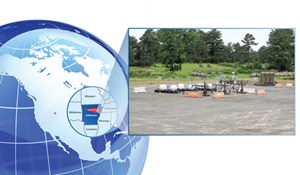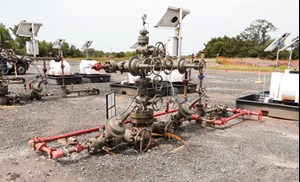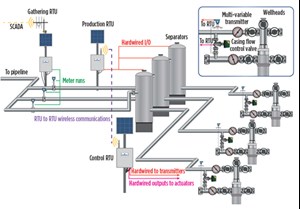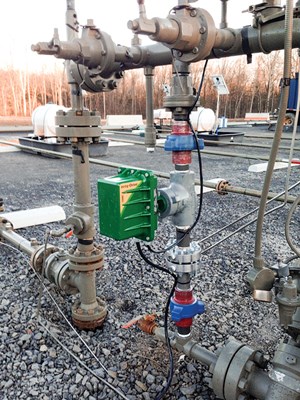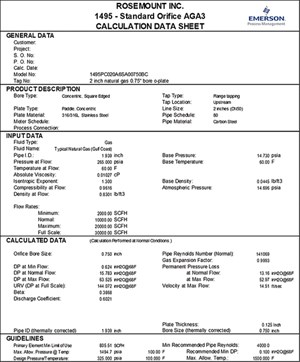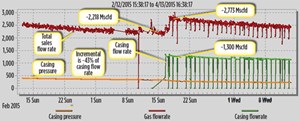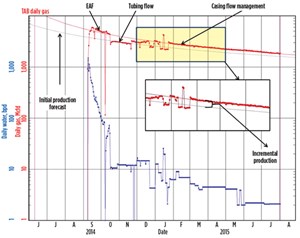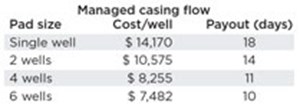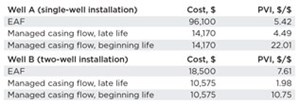Accelerated production improves shale well economics
Southwestern Energy has a substantial presence in the Fayetteville shale play of northern Arkansas, Fig. 1. For more than a decade, the company has applied horizontal drilling practices. Production is natural gas, with a nominal gross heating value of 980 Btu/scf. Water volume is on the order of 15 bbl/MMscfd. Flowing casing pressure is in the 255-psig range.
In a mode known as Extended Annular Flow (EAF) (Fig. 2), initial production is through both casing ports, enabling the well to produce at higher rates than through the tubing alone. During this period, which can last several months, rental equipment, as well as additional supervision, is required. At some point, the rental equipment is released, and normal tubing flow operations begin.
ALTERNATIVE METHOD
In the latter part of 2014, Southwestern Energy began testing an alternative method—casing flow management. This approach is based upon controlling flow from one port of the casing, to obtain an effect similar to using EAF during the entirety of the well’s free-flowing lifecycle phase.
The typical pad configuration, based upon this annular flow tactic, is depicted in Fig. 3. The basic technique is to install a tubing bypass line with an automated valve, under the control of a Remote Terminal Unit (RTU). All equipment is mounted, to facilitate easy removal at a point in the free-flow phase, determined by the operator.
A flanged orifice was selected as the primary flow element. Several factors influenced the choice of an electronic control package. Outdoor environments require a rugged design that handles a wide range of operating temperatures. There is no electrical power available onsite, forcing the entire package, including a choke actuator, to be solar-powered, Fig. 4. The RTU has to implement proportional-integral-derivative (PID) control loops and execute specially coded algorithms. Communications with an existing SCADA system are a necessity.
Multi-well sites have up to 10 wells present, eight of which may be suitable candidates for automation at any given time. The RTU has to handle such configurations in order to minimize overall total installed cost. Lastly, there are other permanently mounted RTUs dedicated to the overall pad control and measurement functions, from which sales flow and site ESD information are available. These data have to be accessed, to implement casing flow control.
To address the Control RTU requisites, Southwestern Energy selected the Emerson FloBoss series of flow computer controllers. Completing the package meant supplying enclosures, a solar power system, choke, actuator and customized programming. Experitec, Inc., a process control equipment and instrumentation company, provided the final integrated solution.
WIRELESS PAD COMMUNICATIONS
Being in close proximity to the wells, the control equipment package could be implemented suitably with commonly available wired instrumentation. However, another design issue arose. Flowrates and ESD information resided with other RTU’s present at the well site for pad level control and sales gas measurement. Long cable lengths proved to be susceptible to lightning-induced, high-voltage transients in the past, which can cause equipment damage. Therefore, wireless communication became an attractive solution. This goal was met easily, using the functionality of the vendor’s Distributed RTU Network. Various RTU’s have the ability to pass data points between one another over a propriety wireless network.
FLOW CALCULATIONS
Early in the conceptual process, it was recognized that the flow calculations did not have to meet the requirements for API and American Gas Association custody transfer. The reason was that the measured flowrate was used only for the purpose of control, not to meet any contractual considerations. This fact implied that the piping layout did not have to conform to custody transfer standards, permitting an easier and lower-cost construction. It further promoted reduction of mathematical work within the controller, which, as a consequence, could expand to handle more meter runs.
The calculation for the casing orifice flow was performed using a Standard Orifice Calculation sheet (Fig. 5) and solving for “DP at Normal Flow,” using a fixed orifice size to yield a K factor:
 (1)
(1)
To get an indicated flowrate in SCFH at fixed pressure and temperatures, the square root of the actual, measured DP is multiplied by the K factor:
 (2)
(2)
To arrive at the current flowrate, pressure and temperature compensation is applied, as below:
 (3)
(3)
Where:
Qc = Current flow
Qi = Indicated flowrate from the square root output of the DP Xmtr that has been ranged, per the Orifice Calculation sheet.
P1 = Expected normal flowing pressure from Orifice Calculation Sheet (in terms of absolute).
P2 = Actual flowing pressure (in terms of absolute).
T1 = Expected normal flowing temperature from Orifice Calculation Sheet (in terms of Deg R, or Deg K).
T2 = Actual flowing temperature (in terms of Deg R, or Deg K).
The calculation for critical flow uses the Turner [1] version formula, which normally is applied for operation above 1,000 psi, flowing pressure. Even though the Fayetteville flowing pressures would typically dictate a Coleman [2] version, Turner’s approach was already in general use for other purposes, and results were more than adequate for this application.
A simplified version of the Turner formula is implemented, assuming water is the predominant fluid. Due to only small variations between wells, variables, such as surface temperature and compressibility factor, have fixed values:
 (4)
(4)
Where:
V = Critical velocity
P = Pressure
 (5)
(5)
Where:
A = Casing cross-sectional area
d = Casing ID (4.2)
 (6)
(6)
Where:
Q = Critical flowrate
V = Critical velocity
P = Pressure
T = Surface temp (120)
Z = Compressibility factor (0.9)
CONTROL STRATEGY
The casing flowrate is controlled by the Control RTU via a PID (proportional-integral-derivative) loop. The set point is calculated by the unit for a value approximating 50% of the critical flowrate. Critical flowrate is based upon critical velocity, as predicted using the aforementioned Turner [1] equations. It indicates the minimum rate of flow from the well, to lift liquids out of the wellbore. Flow at less than critical velocity allows water to collect in the well, eventually curtailing production.
This set point value forces sand and water to be produced up the tubing, thereby reducing wear and tear on the casing. The tubing flowrate is determined by subtracting the current casing flow from the combined flowrate, derived from an RTU associated with the pad sales gathering function. The rate result is used to trigger an override to the normal casing flow control.
While it is desirable to operate below the critical flowrate for the casing, tubing flow is, of course, the opposite. If the tubing flow falls below an override value, typically associated with the critical rate for the tubing, the PID loop will begin to close the casing choke, to maintain a minimum tubing flowrate. Once tubing flow rises above the override value, the normal casing flow loop regains control. The override value is an operator fixed number of 700,000 scfd, which is known to be considerably above the critical rate for an average well. This number may be computed by the Control RTU in future installations.
There also is an override, based upon time. The casing choke is shut in completely between 5 a.m. and 6 a.m., each day, to build up the casing pressure and increase the subsequent tubing flowrate. This helps clear the wellbore of any accumulated liquids or sand.
There is one last job performed by the device—monitoring for external activity. Driving the tubing flow to zero, due to a shut-in by an operator, or by emergency shutdown situations, will automatically change the casing loop flow set point to zero. Manual reset is required to restart the management system.
FIELD RESULTS
The effects of the casing flow management system are reflected in Fig. 6. Sales gas is shown in red, with casing gas shown in green. Initially, the well was operating by tubing flow, at a rate of approximately 2.218 MMscfd. Flow drops to zero for a few hours, while the system is installed. When the casing flow management system is engaged, the sales rate increases to around 2.773 MMscfd. The incremental production over the tubing flow mode is 555,000 scfd, approximately 25% more than the previous sales rate. It is notable that the incremental amount is only ~43% of the casing flowrate, a consequence of the tubing contribution having reduced from its prior volume. Casing pressure (orange) drops by a nominal 20%. While all wells are different, the average initial incremental flow has been found to be in the range of 50% of the casing flowrate, while a 20% production gain over tubing flow is very typical.
Also indicated in Fig. 6 is the daily 1-hr closure of the casing choke, previously referenced as part of the overall control strategy.
Figure 7 depicts forecasted production, overlaid with realized production, for a common well. Projected production is shown with a gray curve. Actual gas output is depicted in red, with produced water represented by blue. The well is kicked off with EAF mode for maximum flow. A period of tubing-only flow is instituted, which closely tracks the normal production forecast. The introduction of casing flow management yields an immediate increase in production. The difference between the gray and red curves during the managed flow time represents the incremental production. Managed flow will continue until incremental production becomes negligible.
ECONOMIC BENEFITS
Since the project’s inception in 2014, 124 installations have occurred. Total, gross incremental production has been about 3.3 Bcf. Planned installations were due to raise this figure closer to 6 Bcf by late 2015.
While such figures are impressive, the crux of pursing this production lies with economic justifications. As the approach does not influence estimated ultimate recovery, its merit is based entirely upon short-term economic benefits resulting from accelerated production. Table 1 displays simplified economic results, based upon a gas price of $2.75/MMbtu.
The cost per well reduces with a greater number of wells per pad, due to the sharing of the RTU system between the wells. Even with the most-expensive single-well version, project payout falls easily within a 30-day period.
Another advantage offered by the managed technique is that it can recoup deferred production. For instance, downtime during the winter of 2015 caused deferments of approximately 4 Bcf. After a focused effort on new installations, the incremental production averaged 20 MMscfd. Therefore, deferred production was recovered within 200 days.
Table 2 uses Present Value Index (PVI) calculations to compare the performance of example wells, using the EAF method and casing flow management. PVI is a ratio of the Present Value of Future Cash Flows and the Initial Investment required. A PVI value greater than 1 indicates that a project will increase the wealth of a company.
Well A represents a single well that ran EAF for several months. Well B was part of a dual-well installation and used EAF for less than two months. The PVIs for the EAF mode are a respectable 5.42 and 7.61. Installing the casing management system further into the decline curve demonstrates credible PVIs of 4.49 and 1.98. Of most interest are indexes derived from potentially installing casing flow management in lieu of the EAF equipment.
FUTURE APPROACH
The 22.01 and 10.75 PVIs projected from instituting casing flow management at the beginning of well operation are impressive. The results are founded, both in the elimination of rental equipment and the supervision costs associated with the EAF period. During the time that extended annular flow would have been used, the managed flow set point is set for 70% of critical rate. Even with the higher rate, there is some production loss when compared to EAF. However, this deferment time has proven to last only about three months before the production curves of the two modes match. The revenue reduction, resulting from early deployment of casing flow management, is more than compensated by eliminating the additional EAF expenses.
The casing flow management system has now become the preferred choice from the start of operations. ![]()
REFERENCES
1. Turner, R. G., M. G. Hubbard, and A. E. Dukler, “Analysis and prediction of minimum flowrate for the continuous removal of liquids from gas wells,” Journal of Petroleum Technology, pp. 1475-1482, November 1969.
2. Coleman, S. B., H. B. Clay, D. G.McCurdy, and H. L. Norris III, “A new look at predicting gas-well load-up,” Journal of Petroleum Technology, pp. 329-333, March 1991.

